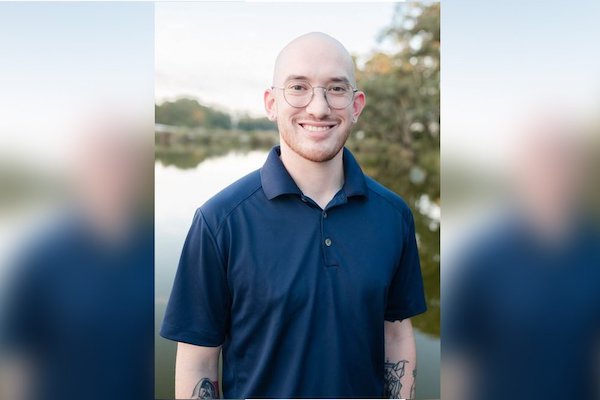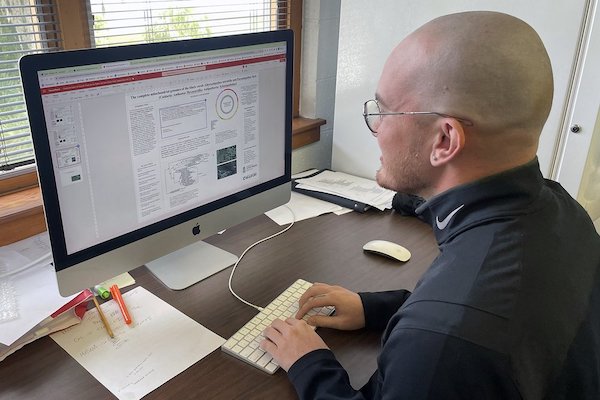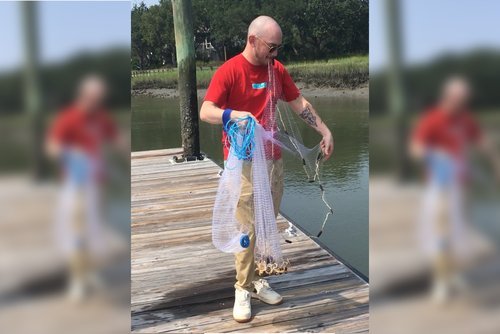Brendan Cruz is Taking Advantage of His Undergraduate Research Opportunities
 USCB Marine Biology student Brendan Cruz.
USCB Marine Biology student Brendan Cruz.Note: This article was previously published in Carolina Crosstalk, USC's student-led undergraduate research magazine, written by Raegan Cole, Associate Writer and Editor.
The ocean contains wonders beyond comprehension, but many researchers are working to make sense of this strange world.
Brendan Cruz is a non-traditional undergraduate attending the USC Beaufort campus. He previously worked as a recruiter for government contracts, but he decided to return to college and get a degree in marine biology.
After being accepted by USCB, he toured campus. Dr. Mercer R. Brugler, who is now Cruz’s mentor, spoke with the tour group in the marine science building, sharing how students have the opportunity to get involved in research before classes start.
Cruz emailed several research professors and joined Dr. Brugler’s team to study black coral mitogenomics. Black corals, named after their black protein-based skeleton, are found in all oceans and hold the record for the deepest (8,900 meters) and longest-lived (4,265 years) coral.
Cruz spent the summer of 2023 comparing the DNA of black coral species found on the Alaskan and Italian coasts to determine how their mitochondrial DNA has changed over time. He expected his role to consist of cleaning glassware and assisting the research team, but Dr. Brugler encouraged him to be much more involved.
Cruz spent the summer working to understand how two deep-sea species (from the North Atlantic Ocean and the Mediterranean Sea) are related to other black corals. The research team used a computer code to separate the mitochondrial and nuclear DNA. Next, they took the mitochondrial DNA and assembled the genetic information into a genome to compare the two black corals. When they weren’t waiting on the DNA sequence to process, the team combed through gene files to ensure they were in the correct order.
One of Cruz’s favorite memories was when Dr. Brugler asked him to locate, download and insert a mitogenome into the computer code to process the sequence himself.
“I’d made the right choice to kind of stepping out of my comfort zone and asking to join the research lab,” he said.
 Research is a significant part of Brandon Cruz’s undergraduate experience.
Research is a significant part of Brandon Cruz’s undergraduate experience.Because of his contributions to the project, Cruz was named the first author of the research paper which is in the process of being reviewed at ZooKeys (Cruz et al.).
After comparing the two different species, they found that their DNA signatures were strangely similar. Typically, mitochondrial DNA evolves quickly, so species in completely different climates should be more genetically distinguishable. The two black corals, while having similar DNA signatures, look radically different.
This discovery has led to more questions that Cruz and Team Black Coral plan to investigate. Their research and the code they created have made mitogenome retrieval and assembly more accessible in this field and others.
Cruz’s time on the project has also inspired him to conduct his own studies. He is monitoring estuaries in the Port Royal Sound in Beaufort for environmental DNA released by lionfish.
Oyster reefs could serve as an essential habitat for lionfish, but whether they live in Port Royal Sound is unconfirmed. This type of DNA consists of genetic material that has been released into the environment, such as skin cells, scales, etc. By simply sampling water, lionfish will never be physically handled.
This method is much more humane as it is not only less stressful for the lionfish, but safer for the researchers because those fish are invasive in the Gulf of Mexico and Atlantic Ocean and are venomous.
Cruz has applied for USC’s Magellan Grant to help support him in this endeavor. In raising awareness of this possible infestation, the public can be protected from this dangerous fish. However, it may also be introduced as a potential low-cost food source but needs to be prepared correctly.
Cruz looks forward to future research opportunities.
“Looking back on the research now, I came a long way in a very short amount of time,” he said. “I’m very happy with the decisions I made and where it’s brought me.”
 Marine Biology student Brandon Cruz collecting specimens from a salt marsh.
Marine Biology student Brandon Cruz collecting specimens from a salt marsh.>>> Postscript: As of March 1, 2024, Cruz is the co-author of three research articles. One, dealing with the mitochondrial genomes of certain black corals, is to be published by ZooKeys, a peer-reviewed open-access journal on biodiversity research. Eight USCB undergraduates and two USCB faculty are co-authors.
Another manuscript on UV radiation tolerance and evolution among corals and anemones is being submitted to Science. It was considered by Nature for 17 days before being rejected. Six USCB undergraduates and two USCB faculty are co-authors.
A third article on the mitochondrial genomes of the Bermuda fireworm is in preparation.
-USCB-